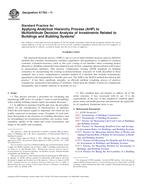Potrebujeme váš súhlas na využitie jednotlivých dát, aby sa vám okrem iného mohli ukazovať informácie týkajúce sa vašich záujmov. Súhlas udelíte kliknutím na tlačidlo „OK“.
ASTM E1765-11
Standard Practice for Applying Analytical Hierarchy Process (AHP) to Multiattribute Decision Analysis of Investments Related to Buildings and Building Systems
Automaticky preložený názov:
Štandardné praktiky pre vykonávanie analytických hierarchický proces (AHP), na rozhodnutie Multiattribute Analýza investícií v oblasti budov a stavebných systémov
NORMA vydaná dňa 1.5.2011
Informácie o norme:
Označenie normy: ASTM E1765-11
Poznámka: NEPLATNÁ
Dátum vydania normy: 1.5.2011
Kód tovaru: NS-42951
Počet strán: 20
Približná hmotnosť: 60 g (0.13 libier)
Krajina: Americká technická norma
Kategória: Technické normy ASTM
Kategórie - podobné normy:
Anotácia textu normy ASTM E1765-11 :
Keywords:
analytical hierarchy process, building economics, decision analysis, economic evaluation methods, engineering economics, hierarchical methods, investment analysis, multiattribute decision analysis, multiple criteria decision analysis, multiple objective decision analysis, operations research methods, Analytical hierarchy process (AHP), Building economics, Composite weights for leaf attributes, Decision analysis, Engineering economics, Hierarchy, Life-cycle cost (LCC) analysis
Doplňujúce informácie
| Significance and Use | ||||||||||||||||||||||||||||||||||||||||||||||||||||||||||||
|
The AHP method allows you to generate a single measure of desirability for project alternatives with respect to multiple attributes (qualitative and quantitative). By contrast, life-cycle cost (Practice E917), net savings (Practice E1074), savings-to-investment ratio (Practice E964), internal rate-of-return (Practice E1057), and payback (Practice E1121) methods all require you to put a monetary value on benefits and costs in order to include them in a measure of project worth. Use AHP to evaluate a finite and generally small set of discrete and predetermined options or alternatives. Specific AHP applications are ranking and choosing among alternatives. For example, rank alternative building locations with AHP to see how they measure up to one another, or use AHP to choose among building materials to see which is best for your application. Use AHP if no single alternative exhibits the most preferred available value or performance for all attributes. This is often the result of an underlying trade-off relationship among attributes. An example is the trade-off between low desired energy costs and large glass window areas (which may raise heating and cooling costs while lowering lighting costs). Use AHP to evaluate alternatives whose attributes are not all measurable in the same units. Also use AHP when performance relative to some or all of the attributes is impractical, impossible, or too costly to measure. For example, while life-cycle costs are directly measured in monetary units, the number and size of offices are measured in other units, and the public image of a building may not be practically measurable in any unit. To help you choose among candidate buildings with these diverse attributes, use AHP to evaluate your alternatives. Potential users of AHP include architects, developers, owners, or lessors of buildings, real estate professionals (commercial and residential), facility managers, building material manufacturers, and agencies managing building portfolios. |
||||||||||||||||||||||||||||||||||||||||||||||||||||||||||||
| 1. Scope | ||||||||||||||||||||||||||||||||||||||||||||||||||||||||||||
|
1.1 This practice presents a procedure for calculating and interpreting AHP scores of a project's total overall desirability when making building-related capital investment decisions. 1.2 In addition to monetary benefits and costs, the procedure allows for the consideration of characteristics or attributes which decision makers regard as important, but which are not readily expressed in monetary terms. Examples of such attributes that pertain to the selection of a building alternative (and its surroundings) are location/accessibility, site security, maintainability, quality of the sound and visual environment, and image to the public and occupants. 1.3 This standard does not purport to address all of the safety concerns, if any, associated with its use. It is the responsibility of the user of this standard to establish appropriate safety and health practices and determine the applicability of regulatory limitations prior to use. |
||||||||||||||||||||||||||||||||||||||||||||||||||||||||||||
| 2. Referenced Documents | ||||||||||||||||||||||||||||||||||||||||||||||||||||||||||||
|
Podobné normy:
Historická
1.11.2009
Historická
1.11.2013
Historická
1.8.2011
Historická
1.8.2013
Odporúčame:
Aktualizácia technických noriem
Chcete mať istotu, že používate len platné technické normy?
Ponúkame Vám riešenie, ktoré Vám zaistí mesačný prehľad o aktuálnosti noriem, ktoré používate.
Chcete vedieť viac informácií ? Pozrite sa na túto stránku.



 ASTM A930-09
ASTM A930-09 ASTM D5899-98(2013)..
ASTM D5899-98(2013).. ASTM E2139-05(2011)..
ASTM E2139-05(2011).. ASTM F1675-13
ASTM F1675-13
 Cookies
Cookies
